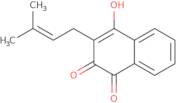Product Information
- 1,4-Naphthalenedione, 2-hydroxy-3-(3-methyl-2-buten-1-yl)-
- 1,4-Naphthalenedione, 2-hydroxy-3-(3-methyl-2-butenyl)-
- 1,4-Naphthoquinone, 2-hydroxy-3-(3-methyl-2-butenyl)-
- 2-Hydroxy-3-(3-Methylbut-2-En-1-Yl)Naphthalene-1,4-Dione
- 2-Hydroxy-3-(3-methyl-2-buten-1-yl)-1,4-naphthalenedione
- 2-Hydroxy-3-(3-methyl-2-butenyl)-1,4-naphthalenedione
- 2-Hydroxy-3-(3-methyl-2-butenyl)-1,4-naphthoquinone
- 2-Hydroxy-3-(3-methylbut-2-en-1-yl)-1,4-dihydronaphthalene-1,4-dione
- 4-Hydroxy-3-(3-Methylbut-2-En-1-Yl)Naphthalene-1,2-Dione
- Bethabarra Wood
- See more synonyms
- Greenhartin
- Ipe-tobacco Wood
- Lapachol Wood
- NSC 11905
- NSC 629756
- Surinam Greenheart Wood
- Taigu Wood
- Taiguic acid
- Tecomin
- C.I. 75490
- C.I. Natural Yellow 16
Lapachol is a natural compound that belongs to the class of sesquiterpene lactones and has antimicrobial properties. It has been shown to have biological properties against infectious diseases, such as Hl-60 cells, which are derived from human leukemia cells. Lapachol inhibits the growth of bacteria by disrupting the mitochondrial membrane potential and inducing cell death through a number of different mechanisms. This compound also binds to Toll-like receptor 2 (TLR2) and TLR4, which are receptors on immune system cells that recognize bacterial products and initiate an inflammatory response. Lapachol also inhibits the activity of DNA topoisomerases I and II, enzymes involved in DNA replication. The inhibition of these enzymes causes the accumulation of unbroken DNA strands that form so-called "DNA knots" or "topological traps". These knots prevent the further replication of DNA strands, leading to cell death.





